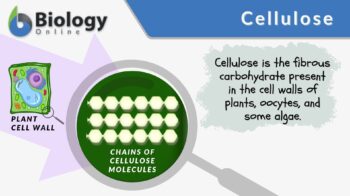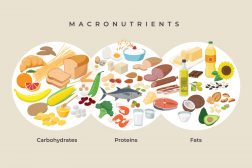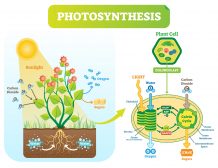
Cellulose
n., [ˈsɛljʊləʊz]
Definition: The fibrous carbohydrate in the cell walls of plants, oomycetes, and some algae
Table of Contents
Cellulose Definition
Cellulose is a polysaccharide consisting of a linear chain of β (1→4) linked D-glucose units: (C6H10O5) n. Polysaccharides are carbohydrates made up of multiple saccharide units. Some of them serve as energy fuel (e.g. starch and glycogen) whereas others have structural functions (e.g. cellulose). It is the fibrous carbohydrate found in the cell walls of green plants, some algae, and oomycetes. It provides strength and rigidity to plant cells.
Chemical Formula: (C6H10O5)n
Etymology: French, from cellule (biological cell)
History and Terminology: In 1838, French chemist Anselme Payen 1795 –1871 was able to isolate cellulose from a plant matter. 1 He also identified the chemical formula of cellulose: (C6H10O5) n, where n refers to the degree of polymerization.
Characteristics
Cellulose is biodegradable, odorless, and has no taste. It is a straight-chain polymer of carbohydrates. It is an organic compound just like the other carbohydrates. It is made up of a linear chain of multiple glucose residues (e.g. 300 to 1000 or more units) linked by β(1→4) glycosidic bond. The hydroxyl groups on the glucose from one chain connect (via hydrogen bonds) with the oxygen atoms on the glucose on another or the same chain.
No glycosidic bonds occur in between the chains. Hydrogen bonds are the ones holding the chains together, side-by-side. Thus, cellulose appears as a microfibril. It renders tensile strength to the cell wall where it serves as the plant’s “cytoskeleton”. The other properties of cellulose depend on the length of the chain or on the degree of polymerization.
Cellulose vs. Starch
Cellulose is similar to starch in being comprised of several glucose monomers. However, the glucose residues in starch are connected by α-glycosidic bonds, i.e. α(1→4) in amylose and α-(1,4) and α(1→6) in amylopectin constituents. Also, cellulose is a straight polymer. It lacks coiling and branches that are present in starch.
Cellulose forms a rather rigid, rod-like conformation. Both of them are biosynthesized by plants. However, plants produce starch primarily as a storage carbohydrate. Cellulose is produced by plants chiefly as a cell wall component. Cellulose is a structural component of the primary cell wall of vascular plants (as well as of many algae and oomycetes).
Cellulose vs. Chitin
Cellulose is the most abundant natural polysaccharide followed by chitin. Cellulose resembles chitin in being a polysaccharide with monomers linked to each other by β(1→4) glycosidic bond. Their difference is on the monosaccharide constituents: cellulose is comprised of D-glucose whereas chitin is a polymer of N-acetyl-D-glucosamine monomers. Chitin has an acetylamine group instead of a hydroxyl group on each monomer. This enables more opportunities of hydrogen bonding between polymers in chitin. Therefore, compared with cellulose, chitin is a tougher polysaccharide, more so when combined with calcium carbonate in a composite material.
Cellulose vs. Hemicellulose
Hemicellulose is another polysaccharide in the plant cell walls. Both hemicellulose and cellulose are polysaccharides but hemicellulose is made by the polymerization of not just glucose. Hemicellulose also contains xylose, galactose, mannose, rhamnose, and arabinose. Moreover, hemicellulose is a branched, cross-linked polymer whereas cellulose is unbranched, straight-chain polymer. They also differ in the way they are synthesized. While cellulose is synthesized outside the cell (by the “rosette terminal complex” at the plasma membrane), hemicellulose is synthesized inside the cell, i.e. from sugar nucleotides in the Golgi apparatus.2
Synthesis
Cellulose is produced naturally by other forms of organisms aside from plants. It is found to be produced by certain bacteria, protists, algae, and animals (e.g. tunicates). The cyanobacteria are presumed to be the first organism to produce cellulose.1
In higher plants, cellulose is produced outside the cell, particularly at the extracellular matrix or cell wall. It is synthesized by the proteinaceous structure called rosette terminal complex floating at the plasma membrane. The complex contains cellulose synthases, which are involved in the synthesis of the cellulose chain.
The cellulose biosynthetic pathway uses glucose as the precursor. The different steps in the pathway are shown below: 3
(1) Glucose → Glucose 6-phosphate (by hexokinase)
(2) Glucose 6-phosphate → Glucose 1-phosphate (by phosphoglucomutase)
(3) Glucose 1-phosphate → UDP-glucose (by UDP glucose pyrophosphorylase)
(4) UDP-glucose → Glucan chains (by cellulose synthase)
(5) Glucan chains → Crystalline cellulose (crystallization process)
Cellulose chains are arranged like “cables” embedded in the matrix. The matrix, in turn, contains various glycoproteins and other polysaccharides. In bacteria, cellulose is produced as a constituent of a biofilm. A biofilm is a microbial community that is stabilized by an extracellular matrix of polysaccharides, proteins, and nucleic acids.1
Degradation
Cellulose that is broken down into cellodextrins and glucose units by hydrolysis is called cellulolysis. Not many animals can digest cellulose-containing diet. Ruminants, such as cows and sheep, are capable of digesting cellulose due to the symbiotic anaerobic bacteria (e.g. Cellulomonas) that have enzymes that degrade cellulose. The enzymes are called cellulases. The bacteria reside in the hindgut where they ferment cellulose. The termites that feed on woods rich in cellulose can also digest it. Some of them have flagellate protozoans or microbial symbionts in their hindgut that produces enzymes that can cleave the glycosidic bonds. Other termites produce cellulases.
Biological Importance
In plants, the cellulose is an important cell wall component. It stabilizes and makes the cell wall rigid and tough. Animals that are capable of digesting cellulose may derive their energy from this polysaccharide. Humans cannot digest cellulose due to the lack of necessary enzymes. However, cellulose may still be incorporated into the diet where it serves as a dietary fiber. Cellulose is naturally present in cabbage, nuts, legumes, avocado, berries, apples, pumpkin seeds, etc.
It may also be chemically processed to be used in the food industry as a creaming agent or thickener for parmesan cheese, ice cream, and other commercial foods.4 When consumed, the cellulose in these foods serves as an insoluble fiber that absorbs water and increases the bulk of stool. The microbiota residing normally in the large intestines of humans are capable of fermenting cellulose, producing short-chain fatty acids and gases. The short-chain fatty acids are absorbed and metabolized by the body.
Cellulose also has various industrial applications. For instance, the cotton plant produces cotton fibers consisting of more than 90% cellulose. They may be harvested to produce clothes, paper, rayon, cellophane, and building materials. Cellulosic material from energy crops has also been used for conversion into biofuels (e.g. cellulosic ethanol).
What is cellulose? Watch the vid below:
Answer the quiz below to check what you have learned so far about cellulose.
Reference
- McNamara, J. T., Morgan, J. L. W., & Zimmer, J. (2015). A Molecular Description of Cellulose Biosynthesis. Annual Review of Biochemistry, 84(1), 895–921. ://doi.org/10.1146/annurev-biochem-060614-033930 Link
- Difference Between Cellulose and Hemicellulose Definition, Structure, Composition, Function, Differences. (2018, January 15). Retrieved from http://pediaa.com/difference-between-cellulose-and-hemicellulose/
- Balaji, A. B., Pakalapati, H., Khalid, M., Rashmi, W., & Siddiqui, H. (2018). Natural and synthetic biocompatible and biodegradable polymers. In: Biodegradable and Biocompatible Polymer Composites. Elsevier Ltd. DOI: 10.1016/B978-0-08-100970-3.00001-8.
- What is cellulose? Definition, Types, the Use in Foods. (2016, June 4). Retrieved from ://www.nutrientsreview.com/carbs/insoluble-fiber-cellulose.html Link
© Biology Online. Content provided and moderated by Biology Online Editors





